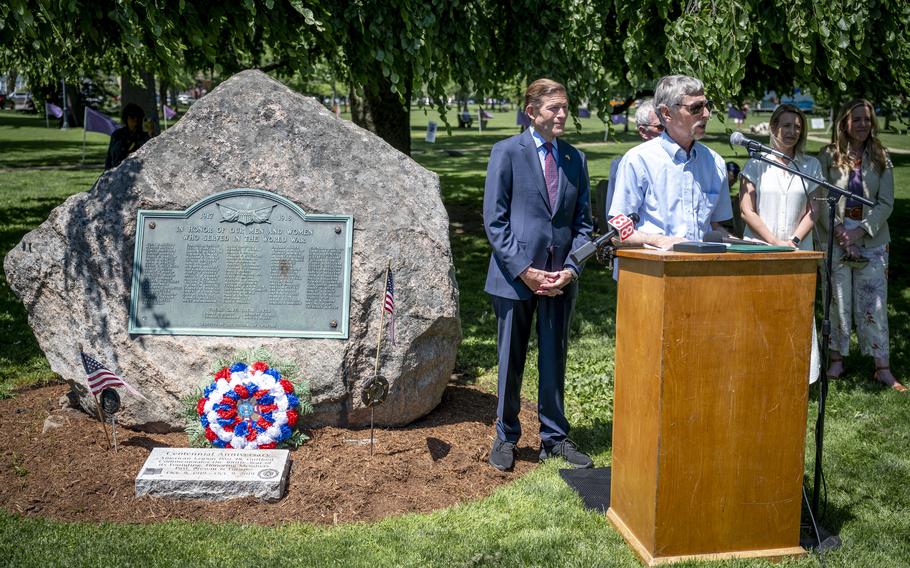
Mr. Rick Maynard speaks to a group of onlookers after receiving a Purple Heart medal from U.S. Sen. Richard Blumenthal (D-Conn.) awarded to his great-uncle Sgt. Paul Maynard during a ceremony in Guilford, Conn., on May 24, 2024. Sgt. Maynard served with the Connecticut National Guard’s 102nd Infantry Regiment in France during World War I and died on the final day of the war. (Timothy Koster/Connecticut National Guard)
U.S. Army Sgt. Paul Maynard of Torrington, Conn., was 21 years old in 1918.
He had recently recovered from a hospital stay because of gas poisoning. He had spent weeks at the front of one of the deadliest campaigns in World War I. And on Nov. 4, 2018, he was happy to be back with his men and sensed the war was coming to a close.
In a letter to his mother written that day, he said: “If I keep having good luck, I guess we’ll see each other before a great while.”
But, on Nov. 11, 1918 — the last day of World War I — Maynard was killed in action while serving in France. He is documented as the last service member from Connecticut to be killed in the war.
Last week, 105 years after his death, he received a Purple Heart.
“He died on the last day of the war. He wrote those words on Nov. 4, and on Nov. 11, the Germans declared an armistice, the war ended, but so did his life,” U.S. Sen. Richard Blumenthal (D-Conn.) said Friday as he presented the Purple Heart to Rick Maynard, Paul’s grandnephew. “Now you may think what a needless thing to give his life, or more accurately his life was taken for nothing.”
But Blumenthal said he was a hero on that day.
“He was doing his job and defending our democracy on that day,” Blumenthal said, “and it was not a senseless death, it was a patriotic and heroic death.”
The ceremony brought closure to the family after their journey to learn more about their great-uncle’s life and military service.
Maynard said he first learned of his granduncle when he and his brother discovered an old “Look” magazine marking the 50th anniversary of WWI in 1964.
“And there was a picture of the Meuse-Argonne Cemetery and of all the thousands of crosses of gravestones there. Right in the front was Sgt. Paul Maynard,” Maynard said. “And the caption ... was that the last day of war was the last day of life for some of the soldiers.”
In 2010 the family discovered a package of letters Maynard had sent home from the war while cleaning out their father’s basement.
“I opened it up and saw about three dozen letters written from Paul to my grandfather from the battlefields of France,” Maynard said. “I started reading these letters and said, ‘Oh my goodness! This is amazing!’ ”
With the help of Christine Pittsley, the special projects curator at the Connecticut State Library, they were even able to pinpoint the exact coordinates of where he died on the battlefield.
“I think Paul was very proud to wear the American uniform and even prouder to serve his country,” said Lisa Ann Maynard in a 2015 documentary about Sgt. Maynard presented by the American Battle Monuments Commission. “Everybody put a lot on the line, and I’m really hoping that Paul will be the catalyst for people to say, ‘let’s look more into our history in this.’ ”
Also in attendance at the ceremony were several current members of the 102nd Infantry Regiment, which is one of the oldest active units in the U.S. military, with a heritage that dates back to the colonial militia.
The 102nd Infantry Regiment has a storied history during World War I. They were the first American unit to see heavy combat in the War during the battle of Seichprey. They also participated in the battles of Champagne-Marne, Aisne-Marne, and the Battle of Verdun, just to name a few.
Maynard and Company M fought in some of the war’s most intense battles, such as the Battle of Belleau Wood, the Saint-Mihiel Campaign and the Meuse-Argonne Offensive.
He was killed on the last day of the war as he worked to pull his men back from the front line and is buried in the Meuse-Argonne American Cemetery, Plot D Row 24, Grave 26.
Contributing: The Register Citizen, Torrington, Conn.; Tribune News Service